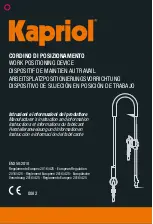
17
DUAL/STEREO COMPRESSOR/NOISE GATE CN-220
This cover prevents also from unauthorised extraction of the unit when rack mounted.
7. BLOCK DIAGRAM AND HOW IT WORKS
In the following shows the compressor/noise gate block diagram. It is draw the channel 1, since
the other is identical, they are simplified (only the options are shown)
In the input stage, we have XLR and JACK connectors wired internally in parallel for the input
signal. Following the signal is electronically unbalanced and crosses the SIDE CHAIN JACK, next the
signal crosses the HP and LP noise gate key filters and the compressor detector. Note that the BAND
COMPRESSOR detector doesn't go by the SIDE CHAIN JACK, for that in BAND COMPRESSOR mode we
could not introduce an external control signal.
At the same time the sign crosses the noise gate, controlled by their detector, and their
corresponding BYPASS switch, and in this point, the signal split to the compressor and to the BAND
COMPRESSOR, controlled by their corresponding detectors. The compressor and the BAND
COMPRESSOR act on the GAIN REDUCTION vu-meter, in order to indicate the gain reduction made on
the input signal. Following the BAND COMPRESSOR ON switch, without pressing gets the compressor
output signal, and pressed the BAND COMPRESSOR one. How you can see, the compressor BYPASS
switch puts the compressor in BYPASS, as well as the BAND COMPRESSOR.
In the output stage, we were the output level adjustment, and the SIDE TEST switch, that upon
pressing get the output directly of the noise gate HP and LP KEY FILTERS. In the SIDE TEST output is
gotten the output level vu-meter reference and later the signal is balanced and goes to the output XLR
and JACK, wired in parallel.
The stereo switch, allow us to select the unit working mode.
8. REPAIR GUIDE
For service purposes, the unit must be open by removing the seven screws on the top cover.
NOTE:
This type of operations takes place with the unit open, for what it should be carried out by a
qualified technician.









































